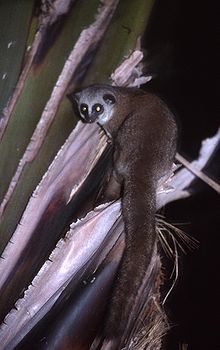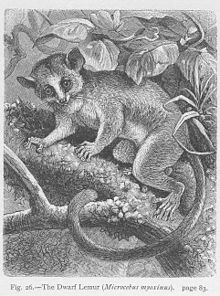| Revision as of 21:27, 8 May 2012 editMaky (talk | contribs)Autopatrolled, Extended confirmed users, File movers, Pending changes reviewers, Rollbackers19,668 editsm Reverted 2 edits by 84.45.192.3 (talk) identified as vandalism to last revision by Helpful Pixie Bot. (TW)← Previous edit | Revision as of 04:52, 10 August 2012 edit undoShelfSkewed (talk | contribs)Autopatrolled, Extended confirmed users, Pending changes reviewers, Rollbackers293,271 editsm fix isbn, rm noticeNext edit → | ||
| Line 25: | Line 25: | ||
| * ''Altililemur'' <small>Elliot, 1913</small> | * ''Altililemur'' <small>Elliot, 1913</small> | ||
| * ''Altilemur'' <small>Weber, 1928</small> | * ''Altilemur'' <small>Weber, 1928</small> | ||
| | synonyms_ref=<ref name=msw3 /><ref name="1997McKenna">{{cite book|last1=McKenna|first1=MC|last2=Bell|first2=SK|title=Classification of Mammals: Above the Species Level|publisher=Columbia University Press| |
| synonyms_ref=<ref name=msw3 /><ref name="1997McKenna">{{cite book|last1=McKenna|first1=MC|last2=Bell|first2=SK|title=Classification of Mammals: Above the Species Level|publisher=Columbia University Press|page=335|year=1997|isbn=0-231-11013-8}}</ref> | ||
| }} | }} | ||
Revision as of 04:52, 10 August 2012
| Dwarf lemurs | |
|---|---|

| |
| Dwarf lemur | |
| Scientific classification | |
| Kingdom: | Animalia |
| Phylum: | Chordata |
| Class: | Mammalia |
| Order: | Primates |
| Family: | Cheirogaleidae |
| Genus: | Cheirogaleus É. Geoffroy, 1812 |
| Species | |
| Synonyms | |
| |
The dwarf lemurs are the lemurs of the genus Cheirogaleus. All of the species in this genus, like all other lemurs, are native to Madagascar.
Description
Measuring 19–27 cm in body length with a tail about 16–17 cm, they are larger than the mouse lemur but smaller than the gentle lemur. Their heads are globular compared to the fox-like heads of the lemurs, but their muzzles are more pointed than those of the hapalemurs. Their hind limbs are slightly longer than their forelimbs, but not as elongated as in lepilemurs or indriids. Dwarf lemurs have an intermembral index of 71 on average. In contrast to most other primates, their grip is similar to that of South American monkeys with objects picked up and branches grasped between the second and third fingers, rather than between the thumb and index finger. Their nails are somewhat keeled and pointed.

Dwarf lemurs roam the lower strata of the foliage in the coastal forests of eastern Madagascar. They are nocturnal and quadrupeds. They have a period of inactivity (torpor) during the winter season lasting between four and five months. Their tail serves as an area for fat storage, most of which is consumed during periods of food scarcity. Like most nocturnal prosimians, dwarf lemurs are reported as living solitary or in pairs. They nest in tree holes where they often sleep together in curled up positions. Their territories are marked by fecal and scent markings. Their diet consists primarily of fruits and flowers and they seem to play a part in the pollination of certain plants.
Classification
As of 2010, 5 species are known.
- Genus Cheirogaleus: dwarf lemurs
- Fat-tailed dwarf lemur, Cheirogaleus medius
- Greater dwarf lemur, Cheirogaleus major
- Furry-eared dwarf lemur, Cheirogaleus crossleyi
- Lesser iron-gray dwarf lemur, Cheirogaleus minusculus
- Sibree's dwarf lemur, Cheirogaleus sibreei
See also
References
- ^ Groves, C. P. (2005). "Genus Cheirogaleus". In Wilson, D. E.; Reeder, D. M (eds.). Mammal Species of the World: A Taxonomic and Geographic Reference (3rd ed.). Johns Hopkins University Press. pp. 111–112. ISBN 978-0-8018-8221-0. OCLC 62265494.
- McKenna, MC; Bell, SK (1997). Classification of Mammals: Above the Species Level. Columbia University Press. p. 335. ISBN 0-231-11013-8.
- ^ Ankel-Simons, Friderun (2007). Primate Anatomy : An Introduction (3rd ed.). Durham, North Carolina: Department of Biological Anthropology and Anatomy, Duke University. pp. 55–56. ISBN 0-12-372576-3.
- Mittermeier, R.A.; Louis, E.E.; Richardson, M.; Schwitzer, C.; et al. (2010). Lemurs of Madagascar. Illustrated by S.D. Nash (3rd ed.). Conservation International. p. 182. ISBN 978-1-934151-23-5. OCLC 670545286.